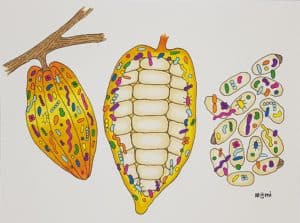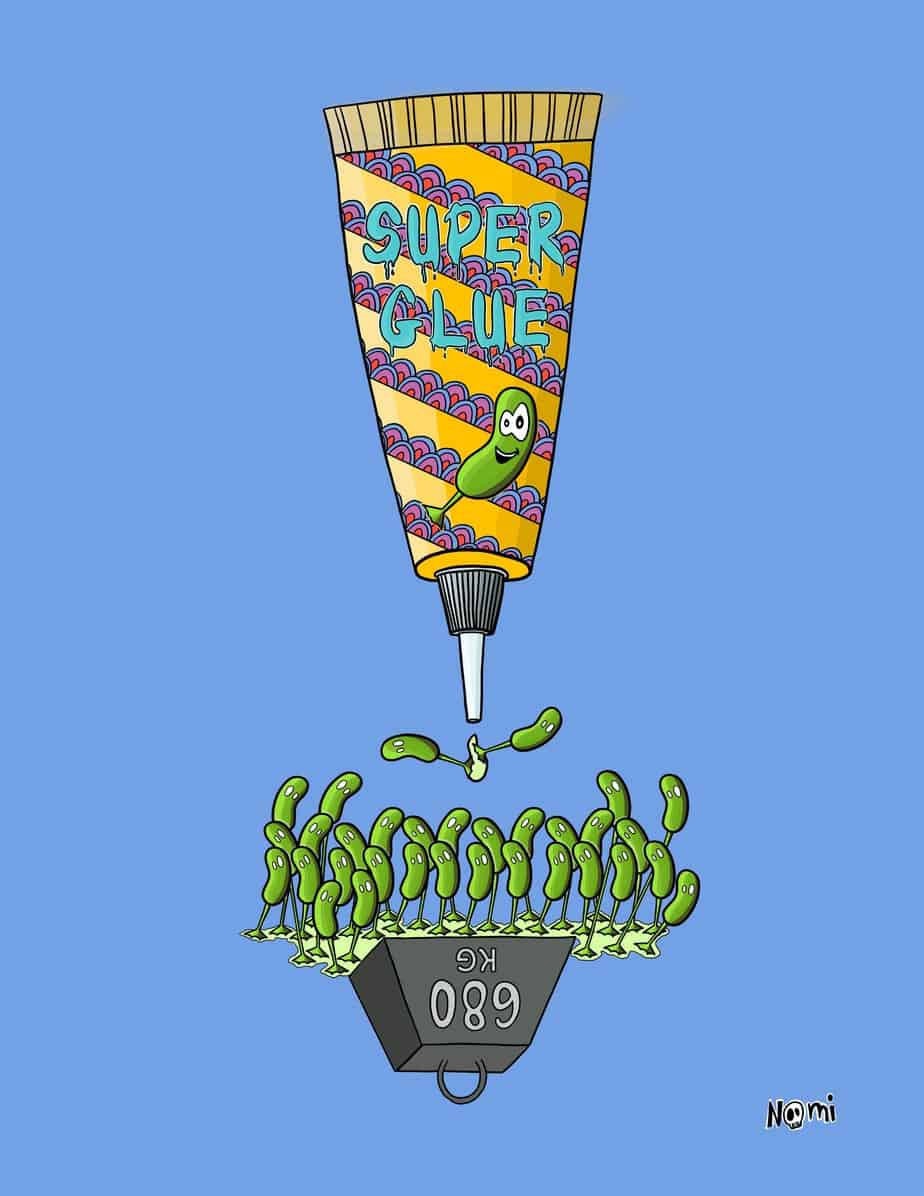What have you eaten so far today? Any bread, yoghurt, sauerkraut or chocolate? Did you have your kombucha, coffee, wine or kefir yet?
Whatever it was, chances are high that part of your food was fermented by microbes. As exceptionally healthy and tasty as fermented foods are, these would not exist if it weren’t for microbes and their fermentation superpowers.
Yet, microbial fermentation is a lot more than processing food and giving it a new taste or aroma. Indeed, depending on who you ask, microbial fermentation means slightly different concepts.
For once, fermentation is a metabolic pathway in some microbes and organisms. It is an energy-saving way to degrade and metabolise substrates and produce complex and energy-rich fermentation products.
Secondly, microbial fermentation describes the process of preserving food based on the fermentation pathway. For this, we let microbes break apart and ferment food in a controlled manner, eventually producing well-known fermented foods, like yoghurt, beer and chocolate.
Lastly, the industrial process of growing microbes in big cultures is often called microbial fermentation. The goal of this process is for microbes to produce a specific product – and often they do so through the fermentation pathway.
As you can see, the different definitions for microbial fermentation are grounded on the same principle: microbes degrading substrates and making fermentation products from them. Here, we will look closer at the biochemistry of microbial fermentation and explore some examples of where this microbial superpower naturally occurs and how we make use of it.
The biochemistry of microbial fermentation
From the view of a biochemist, fermentation is first of all a metabolic pathway to conserve energy. Most organisms gain energy from opening chemical bonds of molecules. This releases the energy-rich electrons that are bound within the bond. They then save these electrons in other molecules or fuel cellular machineries.
Most microbes have one preferred substrate for their metabolism. For many, this is glucose, the same sugar that our cells preferably burn and degrade. By degrading glucose, they (and us) produce several intermediary products, the most important one being pyruvate. This degradation process sets free several electrons, which microbes save in a molecule called ATP. ATP is the main fuel for microbial growth machines, swimming motors or transporters.
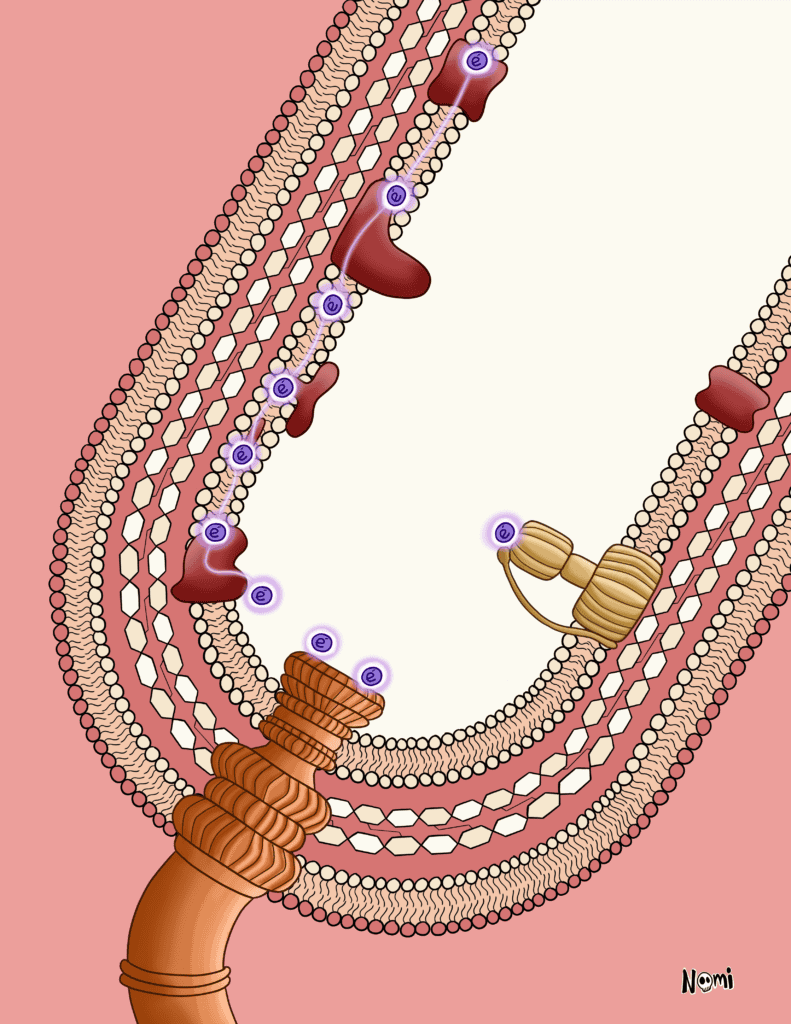
Sometimes microbes find themselves in environments with an excess of their preferred substrate. In this case, setting free all the energy would produce a lot of heat, damaging or even burning the cell. Hence, as an alternative, energy-conserving pathway, they switch to fermentation metabolism.
During this pathway, they degrade the substrate only partly, thus not extracting all available electrons from it. Instead, they use one of the intermediary products and bind it to another molecule in an energy-neutral reaction. This conserves the electrons and energy within the fermentation product.
What makes fermentation so fascinating: Many species have unique fermentation pathways. Depending on their genes, they branch off the fermentation pathway at any intermediate and produce different molecules.
For example, from pyruvate, some microbes produce ethanol, which we use for beer or wine production, and others produce lactic acid, like for yoghurt production. Other microbes ferment substrates like citrate or succinate and produce complex molecules like caffeine or colourful biopigments.
By conserving the high-energy electrons in the fermentation products, microbes produce fewer ATP molecules. Hence, they have less energy available at that moment. But if they need energy later, they can break down the fermentation product to extract the electrons. Often though, their energy levels are so high, that they even export the product to get rid of it.
Fermentation is thus a way for microbes to process molecules and conserve energy. Gladly, we learned to make use of this pathway as microbes help us convert energy-rich substrates into beneficial products.
Microbial fermentation for food preservation
One source of energy-rich substrates are carbohydrate and fibre-rich foods, which is why these are some preferred environments for microbes. By fermenting fruits, vegetables, milk and grains, microbes can grow and spread on seemingly any plant-based substrate.
Gladly, we learned to grow microbes and ferment food in controlled environments, making food fermentation one of the oldest human technologies. Throughout history, many cultures have optimised different fermentation processes and created all kinds of products.
Food fermentation can include adding so-called starter microbes to the food or using those microbes that naturally live in the foodstuff. These microbes break apart the carbohydrate component of the foodstuff to fuel their fermentation pathways.
The resulting fermentation products can be beneficial vitamins, antioxidants or molecules that change the aroma, taste, texture or stability of the foodstuff. The degradation and modification of the food itself and the accumulation of fermentation products, over time, make our well-loved cheeses, coffee, bread, chocolate, beer, wine, kombucha, yoghurt or kimchi.
For example, thanks to microbes, cheese and yoghurt taste and smell differently than the original milk. Coffee and chocolate get their complex and unique aromas only thanks to the microbial fermentation of coffee and cocoa beans.
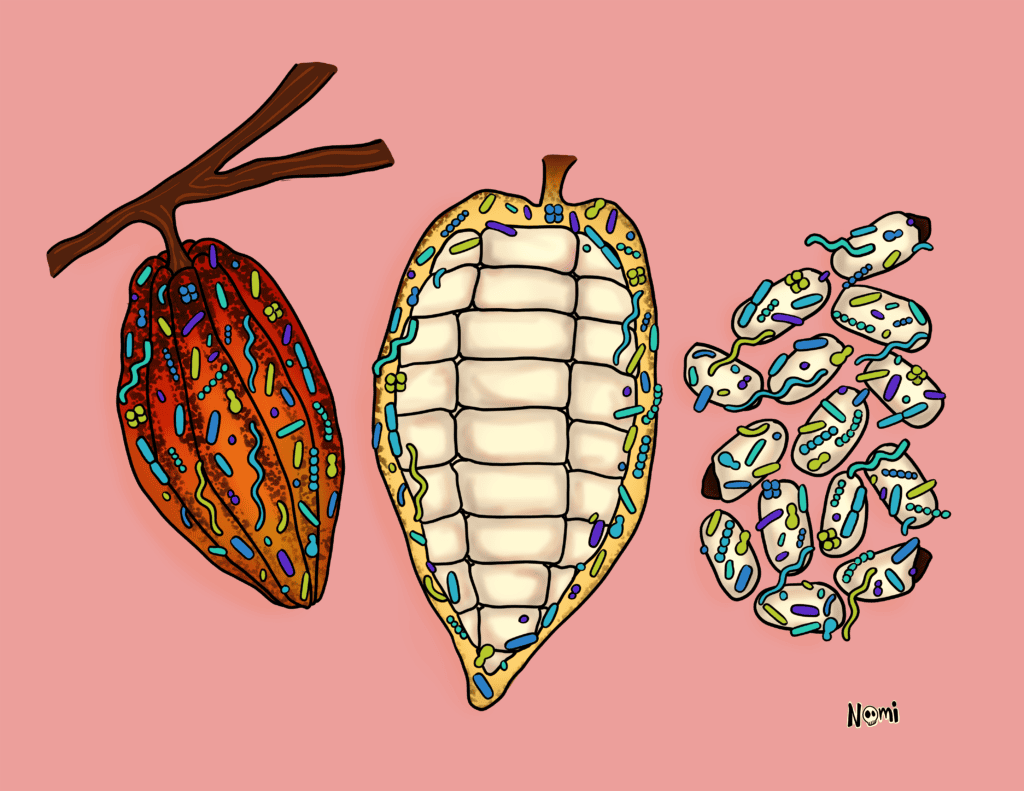
During fermentation, many bacteria produce strong acids from the original substrate. Thus, the resulting food becomes acidic and sour, which prevents other microbes from growing and spoiling the food. That’s why food fermentation became an efficient way to conserve food. Many vegetables, like cabbages, pickles or olives, are thus preserved into sauerkraut or kimchi, sour pickles and olives, and the like. Also making kombucha, kefir or cheese are ways to preserve the original tea or milk.
When fermenting cereals, yeasts mainly produce carbon dioxide or ethanol. Carbon dioxide, for example, in sourdough bread makes the bread rise. In the beer-brewing and wine-making processes, yeast produces ethanol as well as several beneficial and aromatic molecules that give beers and wines their tasteful and diverse aromas.
About the microbes involved in food processing
Each fermented food has a unique community of microbes that changes with the fermentation process over time. With the rise of one microbial species, the pH of the food might change or a certain substrate becomes available, which might kill one species or feed and thus help another one grow.
In many vegetable-based fermentation products, lactic acid bacteria, such as Leuconostoc, Lactobacillus and Weissella, are the primary microbes. They produce acids which prevent food-spoiling microbes from growing. The acids also give the resulting kimchi and sauerkraut their sour and acidic tastes. On the contrary, in alkaline-fermented foods of Asia and Africa and in bean-fermented foods, such as tempeh, miso or natto, Bacillus bacteria are usually responsible for the fermentation process.
In milk fermentation, bacterial cultures are of two types: Lactococcus, Lactobacillus, Leuconostoc and Streptococcus bacteria that acidify the milk. This denatures the milk and produces yoghurt-type products, such as yoghurt, buttermilk and kefir.

As a second step during the cheese-making process, Brevibacterium, Propionibacterium, Debaryomyces, Geotrichum and Penicillium are added. These bacteria and fungi produce more complex molecules and give the ripening cheese its unique flavour, texture and aroma.
For cereal fermentation, yeasts are the most widely used microorganisms, producing beer, sourdough bread, sake and whiskey. For bread-making, the principal yeast is Saccharomyces cerevisiae. Other Saccharomyces species, as well as Torulaspora, Hanseniaspora and Pichia are responsible for fermenting most cereal-based drinks.
How the human body benefits from fermentation
As we’ve learned above, many fermented foods are full of microbes – as long as the food was not heated or pasteurized. Hence, when eating fermented foods, you also take in the microbes in and on the food. And these are ready to settle in your body, feed off your food and do some more fermentation.
After arriving in your gastrointestinal tract, the microbes start digesting part of your food too. They degrade the plant cell structures of vegetables, fruits, cereals, seeds and nuts as well as non-digestible fibres. This releases sugars which gut microbes ferment to short-chain fatty acids and gases, like methane. These fermentation products have beneficial effects on your digestion, mental and gut health as well as your immune system.
Hence, by eating fermented foods you gain beneficial microbes – some of them are the so-called probiotics. And by eating plant-based foods you give your gut microbes the appropriate food to ferment, which is what makes some of them prebiotics.
But this is not the only place where microbial fermentation takes place in your body. For example, Lactobacillus bacteria are the key players within the vaginal microbiome and their fermentation activities influence the health of women.
Within the vaginal tract, host cells provide Lactobacillus with glycogen. From this, the bacterium sets free glucose and ferments it to produce lactic acid and hydrogen peroxide. These molecules decrease the pH creating an acidic environment within the vagina. This acidity kills some pathogenic microorganisms directly and prevents others from growing. Hence, by feeding residential Lactobacillus bacteria, the body helps them grow and in return they protect it.

Microbial fermentation as a pillar of industrial production
The more we learn about microbes, bacteria and their fermentation pathways, the better we can use their metabolic superpowers for our own good. Especially the biotechnology and food industry are making great use of microbial fermentation.
We now grow microbes in big batches and harvest fermentation products, like bioethanol, lactic acid or vitamin B12. In many cases, microbes grow on plant-based products or even ferment waste into usable and, thus, green products. As you can guess, food fermentation based on appropriate starter cultures is taking place on large scales to produce many of our beloved foods.
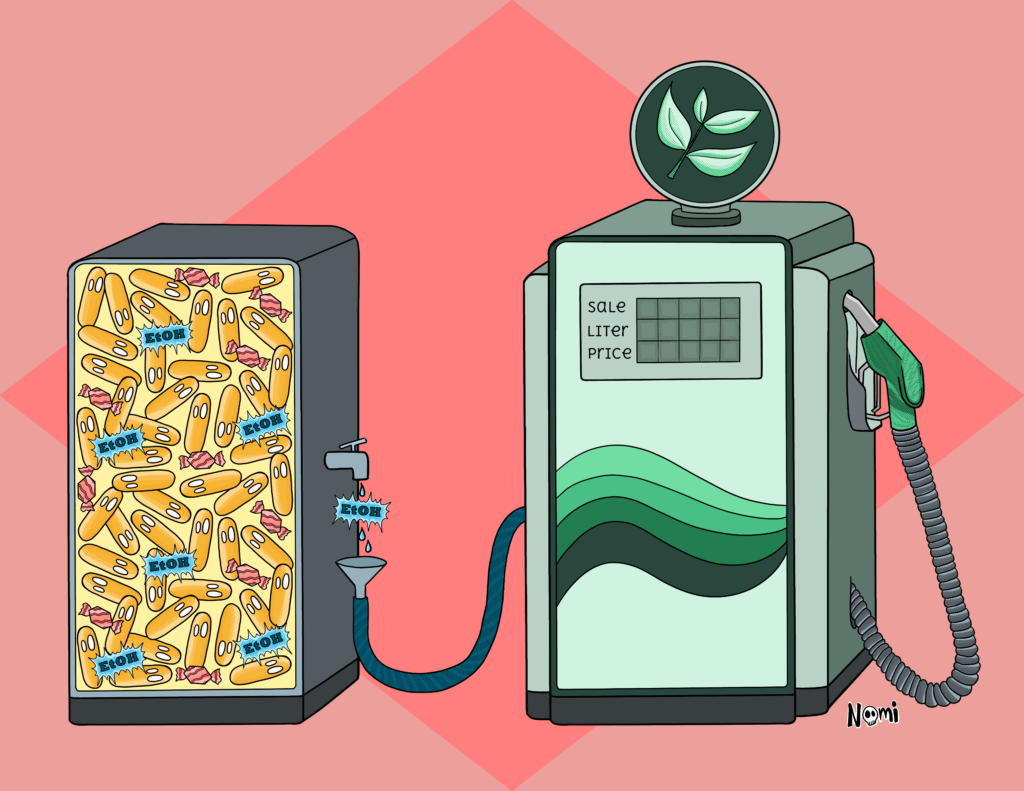
As such, microbial fermentation is an essential part of our lives. Not only as a fundamental process in cellular metabolism and thus human health, microbial fermentation has become a key pillar in food production and preservation as well as industrial production.
As a sustainable tool to produce plant-based foodstuffs, pharmaceuticals and fuels, microbial fermentation may even play a crucial role in our journey towards a greener and more resilient future. Just another reason to be grateful to microbes and their fascinating superpowers.

